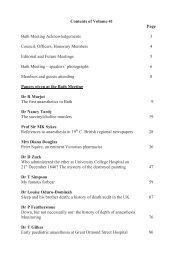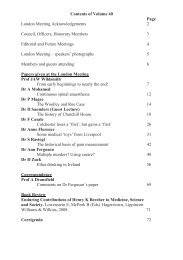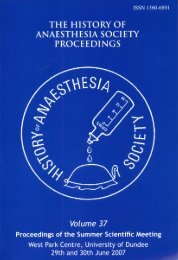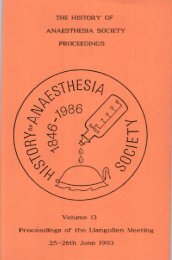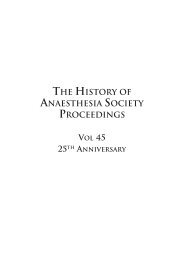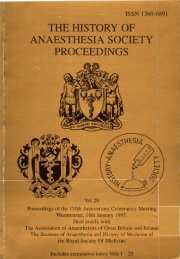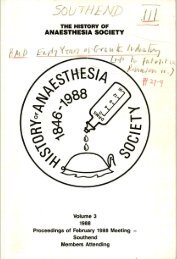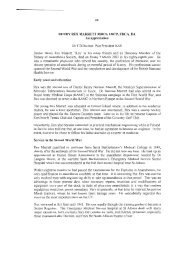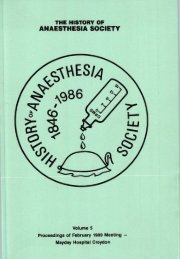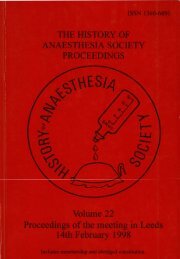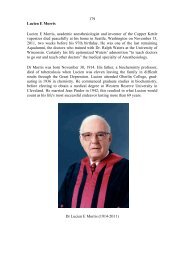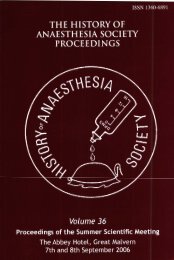Volume 9b - History of Anaesthesia Society
Volume 9b - History of Anaesthesia Society
Volume 9b - History of Anaesthesia Society
Create successful ePaper yourself
Turn your PDF publications into a flip-book with our unique Google optimized e-Paper software.
landings, he was posted to teach airborne medical <strong>of</strong>ficers the use <strong>of</strong><br />
chlor<strong>of</strong>orm, the only agent they were permitted to take with them,<br />
His m role for the D-Day landings was in camand <strong>of</strong> a hospital ship<br />
(Mspital carrier 64). In peacetd, she was the 'Amsterdam1 on the<br />
Harwich to Hook <strong>of</strong> Iblland route. He trained his teams thoroughly; they<br />
loaded and unloaded 300 Canadian sailors as mock casualties in simulated<br />
disasters. Frm D-Day onwards he worked fmn the Normandy landing<br />
beaches. The ship was anchored close in-shore as Casualty Clearing<br />
Station for Juno Beach, the scene <strong>of</strong> some <strong>of</strong> the heaviest fighting. Many<br />
<strong>of</strong> the casualties £ran Juno beach were French Canadians and,<br />
consequently, his ccm~nd <strong>of</strong> the language was useful. Featherstone's son<br />
landed on the adjacent Sword beach and was badly wounded. At 7am on 7<br />
August 1944 whilst sailing from Juno Beach to Southampton, the<br />
'Amsterdam' was shaken by two almt simultaneous explosions. 'The ship<br />
broke in two, and sank in less than a quarter <strong>of</strong> an hour. The training<br />
which the unit personnel had received was such that everyone behaved as<br />
if on another exercise. Over 200 <strong>of</strong> the 260 ptients were savd; what<br />
loss <strong>of</strong> life there was, was caused almost entirely by the explosions.<br />
Tnere was no rescue ship about and no signal could be sent, It<br />
eventually a naval launch came along, and a cruiser was called up to<br />
rescue them. Henry was awarded the OBE for this exploit. His next<br />
posting was to the hospital ship 'Empire Clyde', sailing between the<br />
Mediterranean ports and the UK, ht ill-health caught up with him, and<br />
he was boarded out on the day after V' Day.<br />
Henry resun4 his pst at Birmingham General Hospital. He had been away<br />
amst six years, hat he was still only 51 years <strong>of</strong> age and thile he ~ms<br />
on active service others had taken over m y <strong>of</strong> the roles he had played<br />
at local, regional and national level. Much <strong>of</strong> his private practice had<br />
gone, so tm had his seat on the Council <strong>of</strong> the Association, though he<br />
became a Trustee. He was still an enthusiastic teacher <strong>of</strong> r,?edical<br />
students in his hospital practice and although he was the most senior<br />
consultant, he would regularly anaesthetise for the minor operations<br />
list done by the house surgeon. He tauyht the history <strong>of</strong> anaasthesia and<br />
demnstrated the use <strong>of</strong> historical apparatus, including Hewitt's nitrous<br />
oxide apparatus. He rarely used trichlorcethylene. He objected to its<br />
price because he lrnew it was supplied , without waxoline blue, for dry<br />
cleaning at a fraction <strong>of</strong> the merlical price. He spke highly <strong>of</strong> its use<br />
in dry cleaning. He was contracted for four sessions when the Nations1<br />
Health Service was introduced in 1948. He also continued his overseas<br />
visits and was invited to present ppers at prestigious conferences in<br />
Boston ard Montreal.<br />
The Association <strong>of</strong> Anaesthetists awarded him the first John Snow Xedal<br />
in 1946, and in 1947 he received the honorary degree <strong>of</strong> Doctor <strong>of</strong> Lam<br />
fran Edinbyh University as part <strong>of</strong> the Simpson Chlor<strong>of</strong>ornl Centenary<br />
Cameroration. He was elected an Honorary Fellow <strong>of</strong> the Faculty <strong>of</strong><br />
Anaesthetists <strong>of</strong> the Royal College <strong>of</strong> Surgeons in 1962.



